Here are a few more examples of earlier polearms in fairly complex shapes for their period. The time frame on these should fall in Alexi's parameters.
[ Linked Image ]
The morgarten example is based on a surviving piece the others are art sources thus good solid dating. The second group of examples that Alexi posted in the thread shows a similar item to the morgarten example with the added back spike on a separate socket, independent on the main head. This is stated by some as a development that signifies the earlier halberds from the "sempach" variety. I would be leary of making this such a clear cut distinction. Back spikes seem to be a development of the 1320-1340 for mass acceptance, there are definitely examples earlier than this.
As to the time frame for the "Sparth Axe". I think you would have to distinguish between the term and the weapon. The Sparth Axe terminology I do not have a hard time envelope to give you. I expect a bit later than earlier. The weapon is almost universal in europe from very early, say 1100 at least to well into the 1600's. It is just a very efficient weapon for resources, manufacture and martial use.
Best
Craig
Thanks Craig!
Great input!
It may be redundant, but I am still going to ask. Have you seen anything like the XIVc "glaive?" that I included in my first post? Where might it be from? How long would the haft be? In my opinion it appears to be one of the most elegant of the pole weapons falling within the period of interest (that we saw representations of).
Cheers,
Alexi
Great input!
It may be redundant, but I am still going to ask. Have you seen anything like the XIVc "glaive?" that I included in my first post? Where might it be from? How long would the haft be? In my opinion it appears to be one of the most elegant of the pole weapons falling within the period of interest (that we saw representations of).
Cheers,
Alexi
I forgot. I was going to comment that this style of pole arm is very common in the art, from quite early on. I would say in the 1200 to 1250 range there are numerous examples and it continues right through the period. I will try to detail a few as soon as I can.
Craig
Craig
Alexi: I don't know why I didn't mention this before-You need to sift through the illustrations accompanying Jean Froissart's "Chronicles". These depict events of the 100 years war, the 14th century, but were completed in the late 15th century. So, they actually show the arms and armor of the 15th c., although some of the weapon types were in service long before. Polearms are EVERYWHERE in these wonderful illustrations. The illustration below, of the English capture of Caen in 1346, is a good example of what you'll find at this site: http://www.bnf.fr/enluminures/texte/atx3_01.htm
Click on any or all of the highlighted volume numbers in the text and you'll get a directory of all the illustrations in that volume. It's an incredibly rich resource. You'll enjoy looking through these, and I bet you'll find evidence of the weapon you're interested in. Take special note of the bill shown at center below and the bardiche(?) shown atop the battlements.
 Attachment: 107.95 KB
Attachment: 107.95 KB
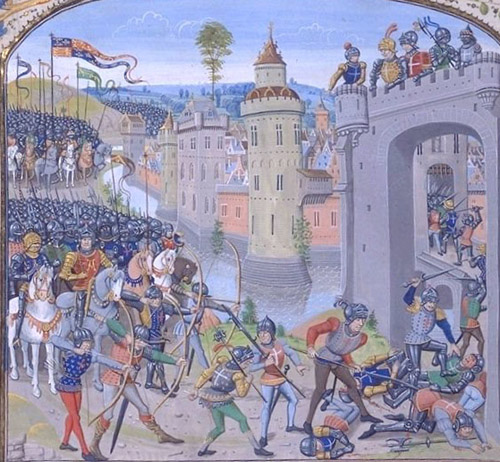
Click on any or all of the highlighted volume numbers in the text and you'll get a directory of all the illustrations in that volume. It's an incredibly rich resource. You'll enjoy looking through these, and I bet you'll find evidence of the weapon you're interested in. Take special note of the bill shown at center below and the bardiche(?) shown atop the battlements.

Last edited by Sean Flynt on Tue 13 Apr, 2004 8:39 am; edited 1 time in total
A couple more. It's interesting to see the length of these weapons. Taking into account the shorter average height of the bearers, it looks like many of these weapons are around 6' long. That makes me feel better about the length of the Windlass voulge and Swiss axe, because I wondered if they were ahistorically short at 5'7" and 5'9", respectively. There seems to be significant variety in the length of the hafts shown in Froissart. Now I'm REALLY wanting that voulge!
 Attachment: 29.15 KB
Attachment: 29.15 KB
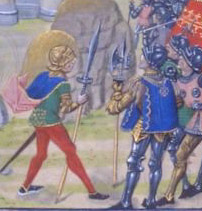
 Attachment: 61.79 KB
Attachment: 61.79 KB
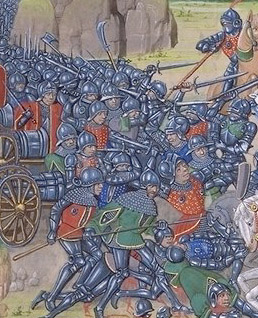


Sean,
Thanks for the link. I enjoyed looking through it.
Thanks for the link. I enjoyed looking through it.
| Craig Johnson wrote: |
| Here are a few more examples of earlier polearms in fairly complex shapes for their period. The time frame on these should fall in Alexi's parameters.
[ Linked Image ] Best Craig |
That morgarten 'halberd' is I think more properly a volgue, as it has more of a cleaver like blade than the smaller axe - like blades of later halberds, which also often had that funny convex shape. Most of the depictions of early swiss 'halberds' seem to be volgues of this sort. Osprey Military books "The Swiss at War", by the way, is a good source for this.
I think the lattter types were more specialized for cutting through heavy armor.
JR
Fellow forumites,
I saw this "english partisan" pole weapon at museum replica's web site. I would have called it a "glaive" but that is just me. I think that similar weapons were used during 13-14c, so it might be a viable choice for a period pole weapon. Since it comes unmounted, I might be able to get around some of the problems people have experienced with mrl shafts, provided I an mount it properly :lol: As expected, I am asking for opinions and comments on this particular product. In an earlier post on this thread several favorable comments were presented on behalf of the mrl german voulge and the swiss poleaxe. Since the mrl products are hit-or-miss I wanted to get an opinion on this "partisan" as well.
Cheers,
Alexi
 Attachment: 9.65 KB
Attachment: 9.65 KB

mrl english partisan
I saw this "english partisan" pole weapon at museum replica's web site. I would have called it a "glaive" but that is just me. I think that similar weapons were used during 13-14c, so it might be a viable choice for a period pole weapon. Since it comes unmounted, I might be able to get around some of the problems people have experienced with mrl shafts, provided I an mount it properly :lol: As expected, I am asking for opinions and comments on this particular product. In an earlier post on this thread several favorable comments were presented on behalf of the mrl german voulge and the swiss poleaxe. Since the mrl products are hit-or-miss I wanted to get an opinion on this "partisan" as well.
Cheers,
Alexi

mrl english partisan
Hi all
if you want to see some good examples of polearms... check out the auction house pic's
http://www.hermann-historica-ohg.de/gb.html
check out some of the pic's in the catalog....
Greg
if you want to see some good examples of polearms... check out the auction house pic's
http://www.hermann-historica-ohg.de/gb.html
check out some of the pic's in the catalog....
Greg
| Greg Thomas Obach wrote: |
| Hi all
if you want to see some good examples of polearms... check out the auction house pic's http://www.hermann-historica-ohg.de/gb.html check out some of the pic's in the catalog.... Greg |
You are right Greg, there are a lot of nice pole arms examples on Hremann Historica's web site, but the vast majority of them do not fall within the period of discussion (13-14c). One of the reasons I started this thread is because there are not a whole lot of surviving pole arms from that period (as compared to 15c and later), and even smaller number are being reproduced.
Alexi
Hello Alex
Finally found the pics I had mentioned to you. Here are two. The artist did several all in the same vein.
The detials for the first pic.
DUCCIO di Buoninsegna
Christ Accused by the Pharisees
1308-11
Tempera on wood, 49 x 57 cm
Museo dell'Opera del Duomo, Siena
The second pic is by the same artist but different pic in the series.
[ Linked Image ]
[ Linked Image ]
Sorry it took me so long.
Best
Craig
Finally found the pics I had mentioned to you. Here are two. The artist did several all in the same vein.
The detials for the first pic.
DUCCIO di Buoninsegna
Christ Accused by the Pharisees
1308-11
Tempera on wood, 49 x 57 cm
Museo dell'Opera del Duomo, Siena
The second pic is by the same artist but different pic in the series.
[ Linked Image ]
[ Linked Image ]
Sorry it took me so long.
Best
Craig
| Craig Johnson wrote: |
| Hello Alex
Finally found the pics I had mentioned to you. Here are two. The artist did several all in the same vein. The detials for the first pic. DUCCIO di Buoninsegna Christ Accused by the Pharisees 1308-11 Tempera on wood, 49 x 57 cm Museo dell'Opera del Duomo, Siena The second pic is by the same artist but different pic in the series. Sorry it took me so long. Best Craig |
Thanks Craig,
The weapons that stand out are the "sparth axe" like ones on each pic. Are they "sparth axes"? They also look a lot like the the XIVc staff-weapon from Czerny's that I posted picture of earlier on this thread. In a gallery of pictures from the Royal Armouries, I saw another like that.
( [url] https://www.long-sword.com/images/Royal_Armouries_Web2/Royal_Armouries_Web3/index.html[/url])
No info though on what they were called, or who used them.
Thanks again for the info
Alexi
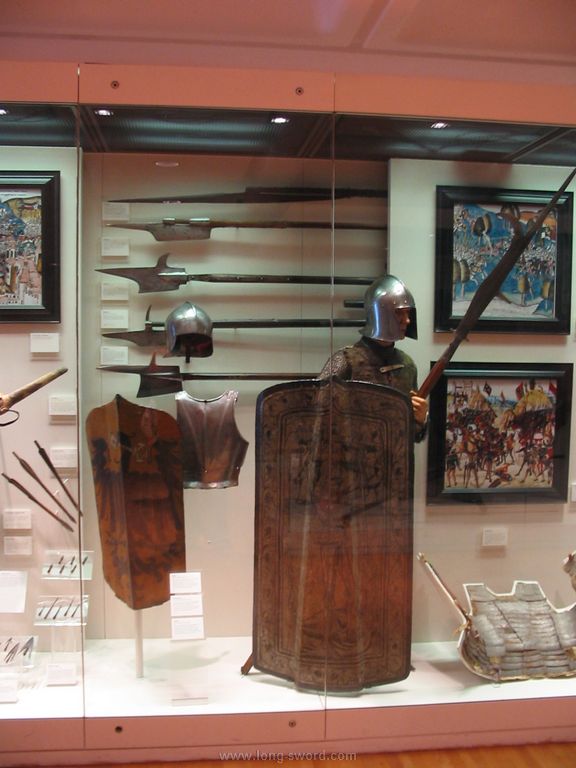
note the top staff weapon
The nomenclature used by any group of individuals in any time period for a specific weapon is almost unknowable in most cases. There are not catalogs of weapon types from the period with illustrations and descriptions. There are several inventory lists from armouries and castles and such. This is why we have the group of terms we use today. Wether we have correctly id the weapons and that this was a common general name for them is far from certain.
Such pieces as bills, halberds, axe, spear are I think very stable terms. The more regional and Colloquial the terms get the more difficult it becomes.
I would say these items are definitely in the development of what we refer to as Sparth Axe, but wether those soldiers carrying these items in the painting addressed them as such in the early 1300's I would be leary of anyone who claimed such with out a nice research paper behind it.
In fact one of the elements that our modern minds have difficulty factoring into such discussions is that a group of individuals , being soldiers of medium or low rank and on campagne almost certainly referred to their weapons in "colorful" and individualistic ways beyond our imagination. Which of these stuck and became popular we do not know. It is the same in any such human endeavor, from the Norse names for their weapons to the pilots and tank drivers in todays army and airforce. The men how use the item are often the ones who find its true name not the designer or makers.
This would probably be a very interesting field of study all on its own!
Very Best and thanks for the great pic.
Craig
Such pieces as bills, halberds, axe, spear are I think very stable terms. The more regional and Colloquial the terms get the more difficult it becomes.
I would say these items are definitely in the development of what we refer to as Sparth Axe, but wether those soldiers carrying these items in the painting addressed them as such in the early 1300's I would be leary of anyone who claimed such with out a nice research paper behind it.
In fact one of the elements that our modern minds have difficulty factoring into such discussions is that a group of individuals , being soldiers of medium or low rank and on campagne almost certainly referred to their weapons in "colorful" and individualistic ways beyond our imagination. Which of these stuck and became popular we do not know. It is the same in any such human endeavor, from the Norse names for their weapons to the pilots and tank drivers in todays army and airforce. The men how use the item are often the ones who find its true name not the designer or makers.
This would probably be a very interesting field of study all on its own!
Very Best and thanks for the great pic.
Craig
"Such pieces as bills, halberds, axe, spear are I think very stable terms. The more regional and Colloquial the terms get the more difficult it becomes."
I think Craig has hit the nail on the head. In a sense of general forms, you have the bill (descended from the Agricultural billhook or scythe on a stick), the glaive (knife on a stick), the axe or halberd (hachet on a stick), and the spear (point on a stick).
The polearm didn't really gain momentum until the end of the 14th century, which is why you're finding so few examples. The earlier examples of all these forms are very simple, and throughout the 15 and 16th centuries they became more elaborate. In general, all of them developed top spikes and then back spikes and finally a slimming down into art works more than tools.
They are a footman's tool, not the Knight's, although the Knights did have their poleaxe as part of their standard repetoire through the 15th century (small axe head, ~3 inches, and usually a hammer on the back side, although some had a spike).
As far as the photo you have from the museum (the one on top), and the Sparth Axe, I've never come across that term before, but I have seen a weapon of very similar form from Scotland being called a 'Jedburg Axe'. I'm pretty comfortable with calling this weapon a Glaive in the general sense, although it definitely could have been a departure from a Bardiche (closer to an Axe).
As far as the weapons' dimensions and scale, most polearms are mounted on square or rectangular shafts, and if you've handled heavy blades on a round pole, you'll know why. When you swing it, the weight of the head and intertia cause it to swing around in your hands. Most are between 6 and 8 feet tall, and weigh in around 4 pounds or so. A Steel or Iron buttcap or band help counter balance the weight of the heads (not to mention serve as an aspect of the weapons 'fight'), and while maybe a bit heavy to the hand, a properly made one will be very nimble and agile if you have the strength to move that much mass.
The windlass polearms are fairly pathetic attempts at general forms, and since time and region did play a lot into their designs, Windlass opted for general 'ish' profiles. A+A has done a great job of reproducing historical arms, and their polearms are no exception, but I tend to actually bang these things up (polearms), and won't waste the money on something that's going to get trashed.
Basically, if you're after a 13th century polearm, go buy yourself a brush hook from a good hardware store, remove the bolted strap, pick up a 7 foot long square piece of Ash, shape the end to fit your billhook, and you've got the almost perfect period billhook designed the same way as the originals, well tempered, and ready to cleave through limbs, Arborial and Otherwise... :)
I think Craig has hit the nail on the head. In a sense of general forms, you have the bill (descended from the Agricultural billhook or scythe on a stick), the glaive (knife on a stick), the axe or halberd (hachet on a stick), and the spear (point on a stick).
The polearm didn't really gain momentum until the end of the 14th century, which is why you're finding so few examples. The earlier examples of all these forms are very simple, and throughout the 15 and 16th centuries they became more elaborate. In general, all of them developed top spikes and then back spikes and finally a slimming down into art works more than tools.
They are a footman's tool, not the Knight's, although the Knights did have their poleaxe as part of their standard repetoire through the 15th century (small axe head, ~3 inches, and usually a hammer on the back side, although some had a spike).
As far as the photo you have from the museum (the one on top), and the Sparth Axe, I've never come across that term before, but I have seen a weapon of very similar form from Scotland being called a 'Jedburg Axe'. I'm pretty comfortable with calling this weapon a Glaive in the general sense, although it definitely could have been a departure from a Bardiche (closer to an Axe).
As far as the weapons' dimensions and scale, most polearms are mounted on square or rectangular shafts, and if you've handled heavy blades on a round pole, you'll know why. When you swing it, the weight of the head and intertia cause it to swing around in your hands. Most are between 6 and 8 feet tall, and weigh in around 4 pounds or so. A Steel or Iron buttcap or band help counter balance the weight of the heads (not to mention serve as an aspect of the weapons 'fight'), and while maybe a bit heavy to the hand, a properly made one will be very nimble and agile if you have the strength to move that much mass.
The windlass polearms are fairly pathetic attempts at general forms, and since time and region did play a lot into their designs, Windlass opted for general 'ish' profiles. A+A has done a great job of reproducing historical arms, and their polearms are no exception, but I tend to actually bang these things up (polearms), and won't waste the money on something that's going to get trashed.
Basically, if you're after a 13th century polearm, go buy yourself a brush hook from a good hardware store, remove the bolted strap, pick up a 7 foot long square piece of Ash, shape the end to fit your billhook, and you've got the almost perfect period billhook designed the same way as the originals, well tempered, and ready to cleave through limbs, Arborial and Otherwise... :)
I would add some non-bladed peasant weapons which are a little less well known, but were probably very important at the time. These would include the two handed threshing flail converted for war, which seemed to be very ubiquitous in every peasant uprising and militia levy from the middle ages to the renaissance. Then there is the so called gudendag, or guden tag, a sort of two handed combination spear / mace used in flanders against French knights in (I believe) the 14th century . That weapon is kind of a natioanlist symbol for flemish independence. Finally the morganstern of Germany, which isn't a morning star in the sense of just being a spiked mace, it's a two handed thrusing spear with a cluster of spikes all over the head, allowing it double duty as a mace.
These weapons, along with the flail, were used with deadly efficacy by the Hussites, as part of their complete military package (which also included crossbows, guns, and their infamous war wagons)
Osprey just came out with a pretty good book on the hussites, who I have found hard to find out informaion on.
Jeanry
These weapons, along with the flail, were used with deadly efficacy by the Hussites, as part of their complete military package (which also included crossbows, guns, and their infamous war wagons)
Osprey just came out with a pretty good book on the hussites, who I have found hard to find out informaion on.
Jeanry
I'd completely forgotten about the Flail family, thank you.
Now I'm just smiling over the idea of a weapon called "Good Day". .. :)
On the faire circuit we've often referred Hammers and Axes as "...a useful tool for cracking open the shells of those shy Englishmen...", but the 'Guten Tag' clearly needs to be added to the Arsenal now. Do you by chance have any photographs of any that wore that specific moniker?
Now I'm just smiling over the idea of a weapon called "Good Day". .. :)
On the faire circuit we've often referred Hammers and Axes as "...a useful tool for cracking open the shells of those shy Englishmen...", but the 'Guten Tag' clearly needs to be added to the Arsenal now. Do you by chance have any photographs of any that wore that specific moniker?
| Matthew Kelty wrote: |
| I'd completely forgotten about the Flail family, thank you.
Now I'm just smiling over the idea of a weapon called "Good Day". .. :) On the faire circuit we've often referred Hammers and Axes as "...a useful tool for cracking open the shells of those shy Englishmen...", but the 'Guten Tag' clearly needs to be added to the Arsenal now. Do you by chance have any photographs of any that wore that specific moniker? |
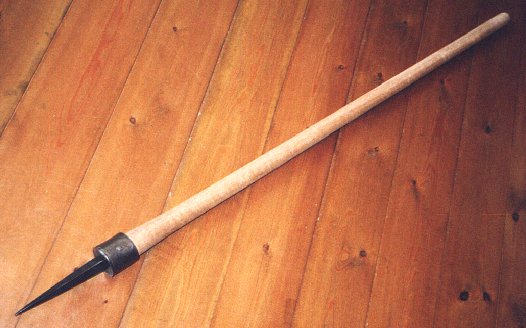
I wouldn't call the Windlass attempts pathetic. The English Bill, French Voulge and German Voulge were all very good (that is nimble, accurate,and tough).
Sean Flynt:
Hey i was reading that you had some of the MRL polearms in action. Was wondering if you could post those :)
Would be totally cool. Thank you.
Hey i was reading that you had some of the MRL polearms in action. Was wondering if you could post those :)
Would be totally cool. Thank you.
Here's the boar spear:
http://www.myArmoury.com/talk/viewtopic.php?t...ght=glaive
Here's the Kuse:
http://www.myArmoury.com/talk/viewtopic.php?t...ght=glaive
Note that the only the heads are MRL/Windlass.
http://www.myArmoury.com/talk/viewtopic.php?t...ght=glaive
Here's the Kuse:
http://www.myArmoury.com/talk/viewtopic.php?t...ght=glaive
Note that the only the heads are MRL/Windlass.
Page 2 of 3
You cannot post new topics in this forumYou cannot reply to topics in this forum
You cannot edit your posts in this forum
You cannot delete your posts in this forum
You cannot vote in polls in this forum
You cannot attach files in this forum
You can download files in this forum
All contents © Copyright 2003-2006 myArmoury.com — All rights reserved
Discussion forums powered by phpBB © The phpBB Group
Switch to the Full-featured Version of the forum
Discussion forums powered by phpBB © The phpBB Group
Switch to the Full-featured Version of the forum